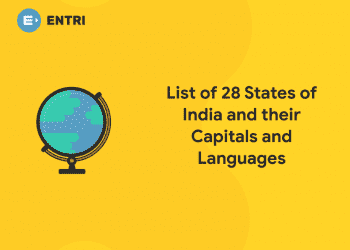Table of Contents
World Tsunami Awareness Day is celebrated on the 5th of November every year to promote national and local risk reduction plans. According to the UN, by 2030, an estimated 50 per cent of the world’s population will have to live in coastal areas exposed to flooding, storms, and tsunamis. Tsunamis are rare natural events but can be extremely deadly. Therefore proper plans and policies will help to reduce the tsunami impact and help to build more resilience and protect populations at risk.
World Tsunami Awareness Day 2025 Date – November 5
In this article readers can get a glimpse on
- History and Celebration of World Tsunami Awareness Day
- World Tsunami Awareness Day Theme 2025
- World Tsunami Awareness Day Quiz
Meaning of the word ‘Tsunami’
1: Who was the first woman President of India?
The term ‘Tsunami’ is a Japanese term that means “harbour wave”. A tsunami is a series of giant waves which is caused by earthquakes or undersea volcanic eruptions and underwater landslides. Tsunamis are the single most deadly of all sudden-onset natural hazards. Millions of people live and work in tsunami-exposed communities across the whole global ocean.
Free UPSKILLING Courses!
Take your first step toward mastering in-demand skills, acing interviews, and securing top-tier jobs with Entri's free upskilling courses.
Start Learning!More about Tsunamis and How Deadly They can be
Tsunami waves can travel at the speed of 800 km/hour and their height can be 20 feet to 300 feet. The speed of tsunami waves hugely depends on the depth of the ocean. The speed of tsunami is fast in deep water while slow down when reaching shallow waters. Worth mentioning that around 80% of tsunamis occur in the Pacific Ocean.
Tsunamis can travel 20-30 miles per hour with waves 10-100 feet high. It causes flooding and disrupts transportation, power, communications, and the water supply. They can take place anywhere along U.S. coasts, mostly coasts that border the Pacific Ocean or Caribbean have the greatest risk.
History of World Tsunami Awareness Day
After the 2004 deadliest Tsunami in the Indian Ocean; The United Nations General Assembly designated 5 November as World Tsunami Awareness Day from December 2015. The basic motive of this day is to increase the awareness about Tsunami among over 700 million people living in low-lying coastal areas and Small Islands.
The Intergovernmental Oceanographic Commission (IOC) of UNESCO raise global awareness about effective actions for mitigating damage, coordinate with national and regional tsunami early warning services, make policies and practices to reduce destruction through its Tsunami Warning System for the Pacific, Indian Ocean, Mediterranean and Connected Sea regions, Caribbean, and North-Eastern Atlantic ocean.
In addition to the above efforts, the IOC also educated Member countries about the regular tsunami communication and evacuation exercises, increase readiness for and understanding of tsunamis among citizens and communities around the world.
World Tsunami Awareness Day Theme 2025
Theme: Be Tsunami Ready: Invest in Tsunami Preparedness
This theme, observed on November 5th, is a direct call to action focusing on the essential role of financial and political commitment in building resilience against tsunamis.
Key Objectives and Messages
- Promoting the Tsunami Ready Programme: The campaign spotlights this UNESCO-IOC-led initiative, a voluntary, performance-based program that recognizes communities that have taken tangible steps to prepare for tsunamis.
- Emphasizing Economic Wisdom: It argues that tsunami preparedness is a sound economic strategy and a public good. Studies show a return on investment in early warning systems ranging from 4 to 36 times the initial cost.
- Strengthening Early Warning Systems: The day advocates for increased investment in advanced detection networks, resilient infrastructure, and regional coherence to ensure timely and trusted tsunami alerts across borders.
- Sustaining Risk Education: It stresses the need for continuous risk communication and public awareness to maintain “tsunami risk memory.” Since tsunamis are rare events, sustained education, like regular evacuation drills, is vital to ensure quick and correct action.
- Alignment with Global Goals: The theme is tied to the Sendai Framework for Disaster Risk Reduction, aiming to reduce disaster losses and protect lives, livelihoods, and economies from devastating tsunami impacts.
- Empowering Local Communities: The campaign encourages local leaders, educators, and citizens to become champions for tsunami preparedness and to participate in community drills, such as the #GetToHighGround movement.
Free UPSKILLING Courses!
Take your first step toward mastering in-demand skills, acing interviews, and securing top-tier jobs with Entri's free upskilling courses.
Start Learning!World Tsunami Awareness Day Previous Themes
World Tsunami Awareness Day is observed annually on November 5th. The themes often align with the targets of the Sendai Framework for Disaster Risk Reduction (2015-2030) and focus on preparedness and early warning.
Here are the themes and their focus points from 2015 to 2025:
- 2025: “Be Tsunami Ready: Invest in Tsunami Preparedness”
- This theme calls for proactive investment in Tsunami Ready programmes, early warning systems, risk education, and infrastructure resilience, shifting focus from reactive response to preparedness.
- 2024: “Empowering the next generation with the lessons of the 2004 Indian Ocean Tsunami – 20 years on”
- The focus was on educating children and youth on tsunami risks and life-saving preparedness, commemorating the 20th anniversary of the 2004 disaster.
- 2023: “Fighting inequality for a resilient future”
- This theme highlighted the reciprocal relationship between disasters and inequality, emphasizing that unequal access to resources and services increases vulnerability.
- 2022: “Early Warning and Early Action Before Every Tsunami”
- The day focused on Target G of the Sendai Framework, which aims to substantially increase the availability of and access to multi-hazard early warning systems by 2030.
- 2021: “Leveraging the Power of Science and Technology to Reduce Tsunami Risk for Current and Future Generations”
- This theme promoted international cooperation and the use of science and technology to strengthen detection and early warning systems, including the Tsunami Ready Programme.
- 2020: Sendai Seven Campaign Target (e)
- The focus encouraged countries to invest in building national and local disaster risk reduction strategies to manage and reduce existing risks.
- 2019: Sendai Seven Campaign Target (d)
- This focused on substantially reducing disaster damage to critical infrastructure and disruption of basic services.
- 2018: Sendai Seven Campaign Target (c)
- The goal was to reduce direct disaster economic loss in relation to global Gross Domestic Product (GDP).
- 2017: Sendai Seven Campaign Target (b)
- The theme focused on the need to reduce the number of people affected globally by disasters.
- 2016: “Effective Education and Evacuation Drills”
- The theme emphasized the importance of community-based education and regular evacuation drills to ensure people know how to respond when a tsunami strikes.
- 2015: “The Fire of Rice Sheaves”
- As the inaugural year, the theme centered on the Japanese folktale that inspired the creation of the day, symbolizing quick, community-driven action to save lives from an incoming tsunami.
How will World Tsunami Awareness Day be Celebrated?
The Tsunami Programme will contribute to the Safe Ocean outcome of the Ocean Decade by making 100% of at-risk communities Tsunami Ready by 2030. Scaling up the Tsunami Ready programme is a testament to what focused, effective international cooperation can deliver, and will make a significant contribution to reducing risk and saving lives. Only together can science, governments and communities achieve this ambition.
You can join events around the world to celebrate World Tsunami Awareness Day on the 5th of November.
How to Stay Safe when Tsunami Threatens?
- If you live near, or regularly visit a coastal area, learn about the risk of tsunami in the area. Some at-risk communities have maps with evacuation zones and routes.
- Learn the signs of a potential tsunami, such as an earthquake, a loud roar from the ocean, or unusual ocean behaviour, such as a sudden rise or wall of water or sudden draining of water showing the ocean floor.
- Know and practice community evacuation plans and map out your routes from home, work, and play. Pick shelters 100 feet or more above sea level, or at least one mile inland.
- Create a family emergency communication plan that has an out-of-state contact. Plan where to meet if you get separated.
World Tsunami Awareness Day Quotes 2025
Following are some lines on world tsunami awareness day:
Tsunamis are always big news around Hilo, grew up always getting ready to escape a tsunami. – B. J. Penn
Everybody has an idea of the tsunami of being a big wave. It is not a big wave. It is a huge amount of water that comes to land. – Juan Antonio Bayona
Whenever an earthquake or tsunami takes thousands of innocent lives, a shocked world talks of little else. I’ll never forget the wrenching days I spent in Haiti last year for Save the Children just weeks after the earthquake. – Anne M. Mulcahy
In some countries, we have had the right to vote for less than 100 years, so the entry of women into political leadership has caused a tsunami. – Iveta Radicova
We imagine ‘the end’ as a world-devastating event, but every time there’s a terrible earthquake, a tsunami, an outbreak of disease – that’s apocalyptic, on a micro-scale. – Marjorie Liu
List of Largest Tsunamis in India Since 1762
| Date | Cause | Max. tidal wave |
|---|---|---|
| 12/26/2004 | Earthquake in Indonesia (Off W. Coast Of Sumatra) with a magnitude of 9.1. The tsunami caused damages in 20 further countries. A total of 227,899 humans died. | 17.30 m |
| 09/13/2002 | Earthquake in India (Andaman Islands, India) with a magnitude of 6.5. | 0 m |
| 11/27/1945 | Earthquake, landslide in Pakistan (Makran Coast) with a magnitude of 8.0. The tsunami also reached Iran, Pakistan. A total of 4,000 humans died. | 11 m |
| 08/27/1883 | Volcano in Indonesia (Krakatau) The tsunami also reached Australia, Sri Lanka, Indonesia, New Zealand, Reunion. A total of 34,417 humans died. | 2 m |
| 12/31/1881 | Earthquake in India (Bay Of Bengal: W Of Car Nicobar Is) with a magnitude of 7.9. | 1.2 m |
| 08/19/1868 | Eruption in India (Andaman Islands) | 4 m |
| 06/16/1819 | Earthquake in India (Kutch) with a magnitude of 7.7. | 0 m |
| 04/02/1762 | Earthquake in Bangladesh (Northern Bay Of Bengal) | 1.8 m |
World Tsunami Awareness Day Quiz 2025
A) Sea wave
B) Harbor wave
C) Big wave
3. How fast can tsunami waves travel across the ocean?
A) 100 km/h
B) 400 km/h
C) 800 km/h
A) Atlantic Ocean
B) Indian Ocean
C) Pacific Ocean
5. Which country was the first to propose observing World Tsunami Awareness Day?
A) Japan
B) India
C) Indonesia
A) About 40%
B) About 60%
C) About 80%
A) Sendai Framework
B) Kyoto Protocol
C) Paris Agreement
A) UNESCO’s Intergovernmental Oceanographic Commission (IOC)
B) WHO
C) UNICEF
A) Go near the shore
B) Move to higher ground
C) Stay where they are
Want More Engaging Questions?
Download our FREE PDF packed with insightful quiz questions to test your knowledge!
🔽 Click below to get your free copy now! 🔽
World Tsunami Awareness Day Quiz 2025 PDF
World Tsunami Awareness Day serves as a vital reminder of the need for preparedness and education to minimize tsunami risks. It encourages nations and communities to strengthen early warning systems, conduct evacuation drills, and promote disaster awareness through education and local participation. By learning from past tragedies, such as the 2004 Indian Ocean tsunami, the world continues to advance in technology and coordination to protect lives and coastal regions.
This observance also highlights the importance of collective responsibility in building resilient communities. Through global cooperation, awareness campaigns, and sustainable coastal planning, we can reduce the devastating impact of future tsunamis. The day inspires people everywhere to stay informed, remain alert, and take action toward a safer and more resilient world.
Free UPSKILLING Courses!
Take your first step toward mastering in-demand skills, acing interviews, and securing top-tier jobs with Entri's free upskilling courses.
Start Learning!Frequently Asked Questions
What is World Tsunami Awareness Day and why is it observed?
World Tsunami Awareness Day is observed every year on November 5. It aims to promote awareness about tsunami risks and preparedness measures. The day encourages countries and communities to develop early warning systems and safety plans. It reminds people of the importance of education and evacuation drills. The observance ultimately helps save lives by improving disaster readiness.
Who proposed the idea of World Tsunami Awareness Day?
Japan proposed the idea to the United Nations in 2015. The country has faced numerous tsunamis and developed advanced warning systems. Japan wanted to share its experience in disaster preparedness globally. The UN General Assembly adopted the resolution soon after. Since 2016, the day has been observed worldwide.
How are tsunamis caused?
Tsunamis are usually caused by undersea earthquakes that displace large amounts of water. They can also result from volcanic eruptions or underwater landslides. The sudden movement creates powerful waves that travel rapidly across oceans. When they reach shallow coastal areas, their height increases dramatically. This causes massive flooding and destruction along coastlines.
Which regions are most vulnerable to tsunamis?
The Pacific Ocean’s “Ring of Fire” is the most tsunami-prone region. This area has frequent seismic and volcanic activity. Countries like Japan, Indonesia, Chile, and the Philippines are often at risk. Coastal areas in the Indian Ocean and Caribbean are also vulnerable. Proper monitoring systems are vital to protect these regions.
What was the impact of the 2004 Indian Ocean tsunami?
The 2004 tsunami was one of the deadliest natural disasters in history. It was triggered by a massive earthquake off the coast of Sumatra, Indonesia. The waves affected more than a dozen countries across Asia and Africa. Over 230,000 people lost their lives, and millions were displaced. The tragedy led to major improvements in global tsunami warning systems.
How can people prepare for a tsunami?
People should know evacuation routes and safe zones in coastal areas. They must move to higher ground immediately after feeling strong shaking. Listening to official alerts and avoiding the coast is essential. Communities should conduct regular drills for quick evacuation. Preparedness and awareness can significantly reduce the risk of casualties.
What is the role of UNESCO’s Intergovernmental Oceanographic Commission (IOC) in tsunami preparedness?
UNESCO’s IOC coordinates international tsunami warning systems. It helps countries share data and strengthen early warning networks. The IOC supports training and awareness programs for coastal communities. It also promotes scientific research to improve tsunami prediction. Its efforts aim to ensure timely and accurate alerts worldwide.
How do tsunami warning systems work?
Tsunami warning systems detect underwater seismic activity and ocean changes. Sensors placed on the seabed measure water pressure variations. The data is transmitted via satellites to monitoring centers. Experts analyze this information to determine tsunami risks. Alerts are then issued to help people evacuate safely.
What actions should be taken during a tsunami warning?
People should immediately move to higher ground or inland areas. Avoiding beaches, rivers, and harbors is crucial. Individuals should follow official updates from authorities. Carrying emergency supplies like water and first aid can help. Staying calm and helping others ensures a faster, safer evacuation.
How does World Tsunami Awareness Day contribute to global safety?
The day promotes education and preparedness against tsunami hazards. It encourages governments to invest in early warning and response systems. Schools and organizations use it to conduct awareness campaigns. The global observance fosters cooperation among nations for disaster resilience. Ultimately, it saves lives by empowering communities to act quickly and effectively.













